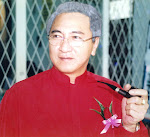Holy Week: Holy Thursday
Except for the resurrection on Easter, Holy Thursday is possibly one of the most important, complex, and profound days of celebration in the Catholic Church. Holy Thursday celebrates the institution of the Eucharist as the true body and blood of Jesus Christ and the institution of the sacrament of the priesthood.
During the Last Supper, Jesus offers himself as the Passover sacrifice, the sacrificial lamb, and teaches that every ordained priest is to follow the same sacrifice in the exact same way. Christ also bids farewell to his followers and prophesizes that one of them will betray him and hand him over to the Roman soldiers.
Later that night, after sundown – because Passover began at sundown- the Holy Thursday Liturgy takes place, marking the end of Lent and the beginning of the sacred "Triduum,” or three, of Holy Week. These days are the three holiest days in the Catholic Church.
Washing of the feet.
I am privileged this year to have been selected as one of the 12 disciples for the washing of the feet ceremony during this Holy Thursday (tonight) in my Parish Church, Stella Maris, Tg. Aru, Kota Kinabalu, Sabah. The washing of the feet done by a priest who humbled himself, is the amazing act we share in continuity with the wonderful, sacred scene we find in John 13.
I reckon that from the priest’s point of view, it is a humble gesture to wash feet, but hardly so in the highly stylized setting of Holy Thursday where, after all, the priest – or bishop or cardinal or pope – stands in for Jesus and thus ironically still secures for himself the place of honor, as if the servant of the servants was really better than the servants themselves. (And I will make sure that I will have me feet scrubbed properly in advance, lest any dirt might fall into the bowl in Father’s presence.)
The washing of the feet ceremony is not to be confused with the sinful and repentant woman in the other Gospels, Mary washes the feet of Jesus, and lavishes costly perfume on them. Jesus accepts this ministry, and only Judas condemns it as overdramatic and wasteful. One can only imagine that when the Last Supper came, Jesus was still been reflecting on the tender intimacy and care of that scene, and realized that even on this most solemn night He might share the experience with his friends at table: as my feet have been washed, I wash yours; and you too, care for one another in this way.
On Holy Thursday 2010, we need to take all this to heart. The Church is still a place of holiness, love, and service, yet it is also a Church that is partly dirty, partly in need of cleansing. There is no longer a Church in which anyone can imagine himself only the washer of feet, and not one in need of washing as well. It is no longer a Church in which cleansing comes only from above. Perhaps the priests — and bishops and cardinals and the pope — can rethink how they commemorate Jesus’ humble, cleaning, tender action this Holy Thursday?
Even today, the priests may indeed be a lot like Peter the first Pope — who did not want his feet to be washed — but like that same Peter, even today they (the priests) might learn to be like Jesus, who let His feet be washed by a woman who was His friend, and then shared the experience with His other friends by doing the same for them.
Source: Abridged from the National Catholic Weekly by Francis X. Clooney, S.J.


.jpg)




No comments:
Post a Comment